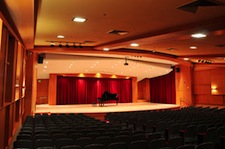It’s the time of year for saving money!
 Last night I went to a concert at University of Colorado’s
Last night I went to a concert at University of Colorado’s
Grusin hall, which is named after Dave Grusin, the jazz musician. It’s a sonic
wonder, but not in a good way. Imagine the largest Live-end dead-end room you
ever saw, fill it with seats, and put the stage on the live end and you’ve got
Grusin. I hadn’t attended a concert at Grusin in at least nine years. I
remembered that it was a dreadfully dead-sounding hall, but knowing and
experiencing are two different things. Because I love my niece Chelsea, who was
a member of the chorus, I was determined to stay for the entire concert.
During the concert, which was primarily a 30-voice chorus with
minimal piano accompaniment, I could hear each voice clearly, especially during
solos, yet the ensemble sound had a hooded, almost muffled character, as if
someone had used an equalizer to cut off the high frequencies.
Out of curiosity I took out my iPod and opened AudioTools and
measured the dB levels. When the room was quiet the meter read 55dB A-weighted.
When the entire chorus was swinging full-bore the loudest dynamic peak was
103dB. Although 103 dB was loud enough to make my wife cover her ears, 103 dB
is not uber-loud. The reason it seemed so loud to her was that most of the
sound was made up of frequencies between 100 and 1000 Hz. This is the most
sensitive part of the entire human hearing range because it happens to be the
frequency spectrum of the human voice. According to one chart I found, the
lowest frequency for a bass is 80 Hz and the highest for a soprano is 900 Hz.
By the second half of the concert I got sufficiently
accustomed to the hall sound that I could listen through it to enjoy the music.
But I started thinking, “What if this were the best-sounding concert hall
within an hour drive?” Then I gave a deep thanks that the University of
Colorado also has another concert hall, Macky Auditorium, where I’ve been
making live concert recordings since 1994.
While Macky ain’t exactly Carnegie Hall, it’s still
decent, with some degree of reflectance and hall sound. After the first year
that J. Gordon Holt and I recorded there he devised an EQ curve to add back in
some of the bass frequencies that are lost because of Macky’s latticework proscenium
shell, which does little to reinforce frequencies below 50 Hz. Macky was
originally built to house a big pipe organ, which currently needs about
$100,000 worth of repair to be fully operable. So instead of a solid roof over
the stage there’s a lattice so the organ pipes behind and above the stage can
be heard. The organ’s dead but the holes remain.
Back to Grusin. As I left the concert I thanked my lucky
stars that we have multiple venues in the Denver/Boulder area to hear live acoustic
music. I also put a big yellow sticky note inside my brain so the next time I have
to attend a concert at Grusin I’ll be ready for a night of straining to hear
the music, even at 103 dB.





